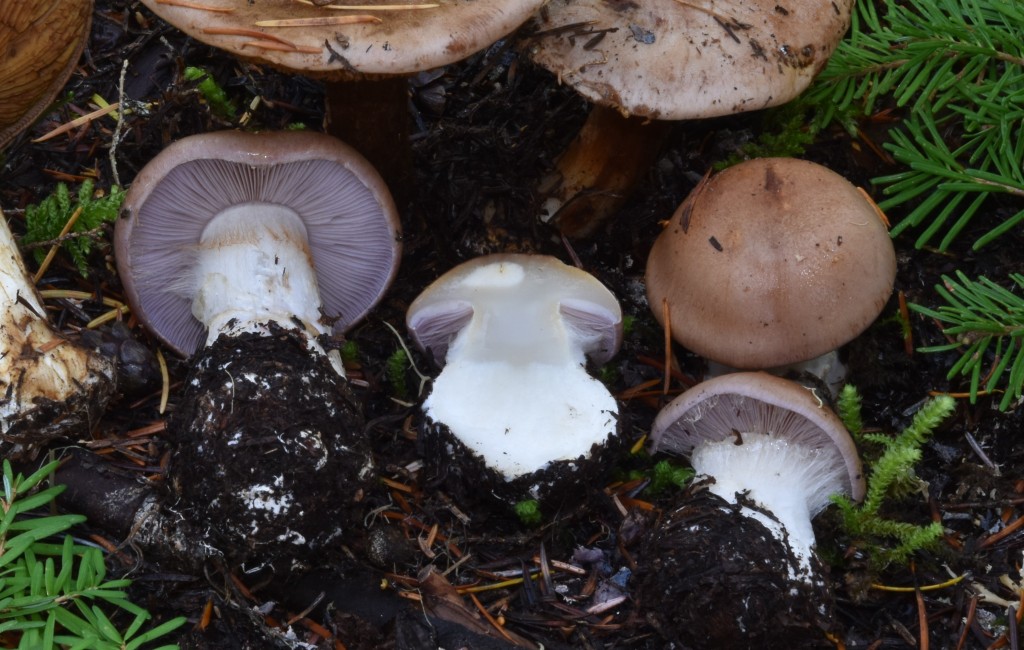Phlegmacium melleum Bojantchev, S.D. Adams & Ammirati
Etymology (Latin): melleus meaning honey colored.
Description
Pileus 40–80 mm diam., hemispherical to convex when young, plano-convex to planoconcave in age margin involute, pinkish buff initially, developing a pink to reddish orange disk, pale yellow at maturity, smooth, glutinous when wet. Lamellae crowded, faintly lilac or beige at first then greyish tan, then brown, as the spores mature. Stipe 40–150 mm long, 15–45 mm wide, cylindric to subclavate, white with brown discoloration where bruised, occasionally with protruding mycelial strands. Universal veil white. Partial veil composed of white fibrils, leaving a sparse annular zone (cortina) on the stipe. Context white, bruising pale ochraceous. Odor earthy to indistinct. Taste mild. KOH negative on all parts.

Note: I do not have a good collection of mature fruitbodies for this species because it was growing closely with Cortinarius subsulfurinus and I made a mixed collection. It was only when I had it sequenced that I realized we had two species growing closely together. This should be a warning to Cortinarius collectors to be careful as we assemble good specimens to photograph! Thankfully, I was able to separate the buttons from the mature specimens and confirm the mixup.Better collections are recorded on iNat by Dimitar Bojantchev, linked here:

Microscopy:
Spores: (10·5–) M1·0–12·0 (–12·5) × (6·0–) 6·5–7·0 µm (mean 11·4 × 6·4 µm), Qav = 1·78, amygdaliform, finely verrucose. Basidia 17–33 × 11–15 µm, 4-spored, cylindro-clavate, clamped. Lamella edges sparsely fertile. Cystidia not observed. Pileipellis a thick epicutis, composed of parallel to interwoven hyphae, 3–15 µm wide, in a gelatinous matrix, hypodermium developed, hyphae 8–22 µm wide. Clamp connections common in all parts.
Ecology and distribution
Phlegmacium melleus has a broad distribution in the Pacific Northwest in conifer dominated habitats. In California it is only known from the northern-most counties, where it is frequently collected.
Discussion
When I first saw this species I called it “Pinky” because of the unusual pinkish buff cap and white stipe which are unusual among Washington Cortinariacea. For California collections the pinkish buff, coupled sometimes with a reddish orange disc are key identification features.
Phylogenetics
IF 901461 – Holotype Genbank OR726388
This species is somewhat isolated phylogenetically and its closest well-known relative is Phlegmacium serarium (Fr.) Niskanen & Liimat. with which it shares morphological features including coloration and stature. The basidiospores have similar size, form, and ornamentation, while the two species differing by more than 12 base pairs in the ITS1/2 marker.
Collections examined: USA. California, Humboldt County, Willow Creek, under Picea sitchensis, Pseudotsuga menziesii, Abies spp., 14 Dec. 2011, DBB39200 (Holotype: UC2060215, Genbank: OR726388). iNaturalist: 188433424; California, Humboldt County, Eureka, HBMS Fair, 19 Nov. 2011, DBB58083 (Genbank: OR726387) 22 Nov. 2013, DBB63968 Oregon, Mt. Hood, Timothy Lake, under Abies spp, Tsuga heterophylla, Pseudotsuga menziesii, Pinus ponderosa, 19 Oct. 2019, SDA618 (Genbank: OR726386) Washington, Chelan County, Table Mountain, mixed conifers, Abies, Larix, Pinus, Pseudotsuga, Picea, 31 Aug. 2008, JFA13219 (WTU), JFA13220(WTU)

Leave a comment